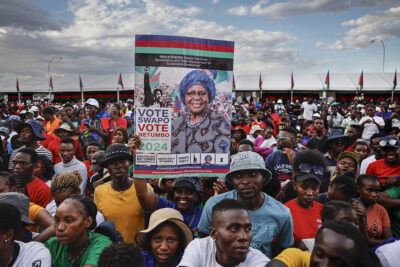In Margaret Atwood’s 1983 short story “Bluebeard’s Egg,” Sally, a disgruntled upper-middle-class wife, attends an evening class in creative writing. One of her assignments is to retell an older version of the Bluebeard story from the point of view of one of the characters involved. In this particular version, Bluebeard asks his wives to take care of not only the many keys to his house but also an egg, which then, smeared with blood, gives away their disobedience. Sally hums and haws over which character to adopt; finally, moved primarily by a desire for originality, she decides to tell the story from the point of view of the egg. Its symbolism seems so frightfully clear, she notes, that this very clarity makes it opaque. Not surprisingly, Sally fails in the end, for “how can there be a story from the egg’s point of view, if the egg is so closed and unaware?”
Several contributors to this forum have noted that the “faith of the old women of Nishapur” tells us very little about female religiosity. It is a trope, positive or negative or somewhere in between, that symbolically defines male religious practice and thereby constitutes particular forms of masculinity. Women here are “rhetorical devices,” tools to think with, “moral foils.” In other words, the “old women of Nishapur” appear as ever so many “eggs” whose point of view we do not, perhaps cannot, know or only know opaquely—indeed, whose very symbolic clarity renders them opaque as subjects. They constitute a “muted category” who are not necessarily silent in and of themselves; the old women of Nishapur clash rather noticeably with other common tropes about old women: as lewd, talkative, indiscrete; as cruel and vengeful mothers-in-law and crazy old hags (which we surmise they might in fact also be, unbeknownst to al-Juwaynī). Rather, they are rendered inarticulate in an ongoing process. This process is never complete as the reduction of potential subjects to other subjects’ symbols is no easy task. But this process is, arguably, essential to the formation of what we call social or ethical worlds, not only in the Islamic tradition but there too full-fledged subjects are made through their relations to other people, and few of these relations are ever equal.
This is not just another way of stating that “the subaltern cannot speak,” although questions of domination are of course crucial. As other contributors to this forum have shown, many of the “old women” might have been of relatively high class and status, if only as mothers of renowned scholars. It was precisely their high status, and their centrality to others’ self-definitions, that turned them into bearers of meaning for others. They might, moreover, actively participate in this process. This is where the egg parallel shows its limits: there is nothing “closed and unaware” about people who inhabit muted categories. On the contrary, these figures tend to be extremely aware, if only of the definitional powers of others that constantly risk overriding their own.
Long ago, Bernard Cohn poked fun at the anthropologists “Philias Fillagap and Lucy Lacuna,” who “have dutifully designed their research project to fill a gap in our existing ethnographic knowledge of Anthropologyland” as a way of reversing the epistemic violence on which so much of our knowledge is based. To simply fill in the “eggs” of history, as ever so many blank spots on a two-dimensional map, would mean to erase a particular form of social and ethical ordering—in fact, to erase “history” itself—and to profoundly misunderstand it. Or, as feminist scholars have long pointed out, “just adding women”—even “old women”—“into a system of thought” still leaves the structures of epistemic violence that render them invisible intact.
* * *
In other iterations of the deathbed anecdote, as Rula Abisaab and Sara Abdel-Latif show in their contributions to this forum, the “faith of the old women” seamlessly becomes that of “the desert,” dīn al-bādiya. Gender and age, it appears, can be replaced by geographic distance, which results in another form of highly symbolic inarticulateness: desert dwellers are either al-Barbar, or Bedouin, speakers of the “pure Arabic” of the pre-Islamic poets—one bad, one good, incomprehensible both. Much can be said about the Islamic image of the bādiya and the way it has been appropriated, productively, by desert-dwellers themselves, particularly in that greatest and most desolate of them all, the saharā al-kubrā, stretching from what is now Mauritania in the West to Upper Egypt and northern Sudan in the east. But what if we compound trope with trope and look at the old women among them?
Although in the Islamic as well as in the European romantic imagination the bādiya tends to be imagined as an archetypal male place, much, if not most, social life throughout the Sahara is and long has been managed by women. Exchange, connectivity, and therefore mobility here are necessary features of life—life is quite simply impossible without them—even for people of apparently sedentary occupations. Throughout the region, this mobility tends to be primarily men’s work. As a result, many adult men tend to be absent for much of the year, trading or herding. They are more likely to die in violent interactions or to be absorbed into a different kind of life, including marriage, elsewhere. Historically, this was compounded by a strong preference for female over male slaves. As a consequence, muted or not, “old women” were pivotal in local social organisations, maintaining and affirming social hierarchies, managing alliances through marriage, and sustaining households. They did this primarily by manipulating, transforming, and controlling young women’s bodies: their younger sisters, daughters, and slaves whose labour granted them the leisure of their intense political lives. This resulted in, on the one hand, the practical predominance of (some) women locally and, on the other, their relative moral and symbolic subordination to (most) men, as mobility and outside connections were highly valued.
Although we can assume that this has long been the case, aside a few sly remarks by external observers (such as Ibn Battuta), hardly any of this transpires in standard historic descriptions. Nor is it prominent in the rich literary, genealogical, and religious traditions that Saharan societies have produced over time and that remain crucial to their self-definitions. Old women, as Timothy Cleveland noted with regards to Mauritania, tend to remember (male) genealogies best—as it is they who forge marital alliances and indeed have produced the children that constitute their raw material. But they do not, by definition, figure into the finished version, or only ever implicitly so. It is al-‘ajā’iz who teach basic literacy to children; it is they who are “responsible for conduct that protects more general cultural survival and autonomy.” But it is not usually they who speak to external observers or write travel accounts for posterity.
The faith of the old women of Nishapur is here mirrored by another trope: that of the “young girl who read the Quran so much that she went crazy.” I encountered this trope during fieldwork in southern Algeria and northern Mali with rural scholarly families, from 2007 to 2009, and its frequent invocation was perhaps intended as a warning to me that too much book-learning would do me no good either. Such girls cannot go out, nor will they ever marry—or this is at least what their sisters say. Instead, they render valuable services to their families as unpaid scribes. Whatever the intellectual achievements of women might be, whatever form their religiosity actually takes, whatever active part they might play in the production of a scriptural religious tradition—which relies, among other things, on diligent labour—the categories they inhabit in both local and external historiography are determined in advance. In the Sahara as elsewhere, a few (elite) women can be known as outstanding scholars, but not very many. The “crazy girls,” one assumes, will eventually grow into quietly faithful old ladies, and only those who know them well or recognize their handwriting in their fathers’ legacy will know that their faith was anything but unmediated. It is thus not so much that women are inarticulate, but that they render possible male articulation and often act as its primary transmitters.
Notions of false consciousness cannot quite capture these dynamics. Locally, many, if not most, decisions are made by women, agreements hacked out, in day-long talking sessions (gayla-s) at which men are only ever passing visitors, hovering beyond the circle of tea-drinking ladies. Men have more important things to do than to gossip about their neighbours; life locally could not exist without the resources, material and intellectual, they bring in from the outside. But neither could they be “desert dwellers” in any real sense of the word without the “anchor” represented by women—to which their “gossip” is crucial. Who is to decide which matters more: the hub of the wheel or its spokes? These are questions of encompassment—who can reduce whom to symbols in whose life-world, under which conditions of collective life, and when playing to which audience—and they are never resolved in any but temporary fashion. Indeed, they cannot be, as “life in the bādiya” intrinsically depends on the delicate interplay between external pulls and internal weight and as the incoherencies thus produced are the stuff of social and ethical life.
* * *
Sally’s egg story failed, but it brought her a sudden realisation: the egg is her husband Ed, whom she loves but cannot understand and who seems irretrievably “stupid,” without any “inner life” at all. His inarticulateness is the result not of his domination by others but of his success; he quite simply does not have to explain himself nor engage with the rules of speech developed by others. Ignorance here is quite as much the privilege of the dominant as is knowledge. The reader, meanwhile, is left to wonder whether the egg was not rather Sally herself, haunted by her constant fear of being “nothing” to the point where this might have become true. Atwood’s story is, like the original Bluebeard, about the limits of knowledge that one can safely seek about others; but also, and perhaps most interestingly, it is about the impossibility of holding constant several mutually incompatible perspectives or of ever deciding beyond doubt which one is “correct.” Stories, as much as social worlds, rely on eggs; if we really recognized everybody’s subjectivity all of the time, we would cease to function in society and be rendered inarticulate ourselves.
What we need to do, then, is to pay more attention to these reciprocal processes of muting and to how they are ordered hierarchically—hierarchically in a sense that allows for internal value reversals, or redefinition. These processes give rise to struggles of encompassment—about who can define whom as pertaining to their own moral world—results of which are never a foregone conclusion, always contextual, and always speak of and reproduce deeply rooted histories of domination. For the “old women of Nishapur,” it was perhaps al-Juwaynī himself who was the egg: a scholar, maybe a prestigious son, far beyond their reach and concerns but crucial for the maintenance of the world they lived in. But, given the hierarchies that shaped this world—and that continue to shape ours—we will never know.












